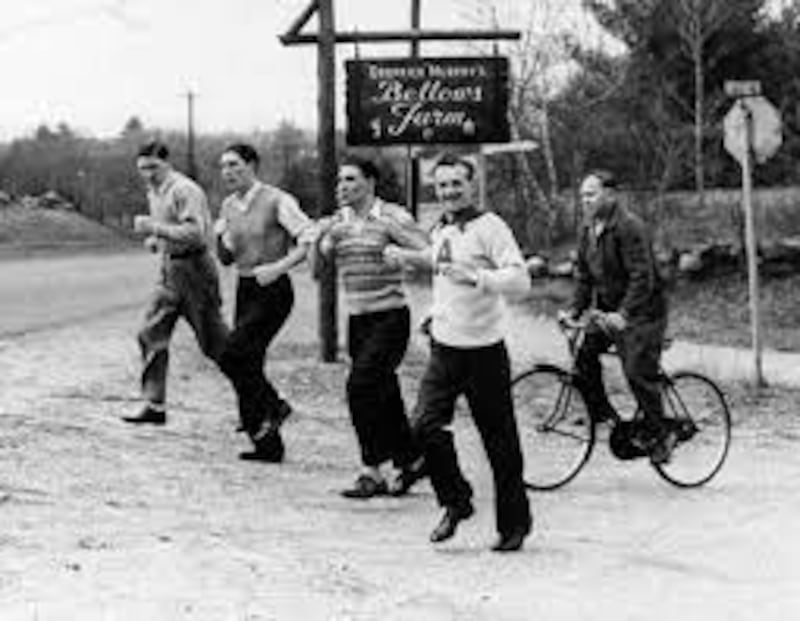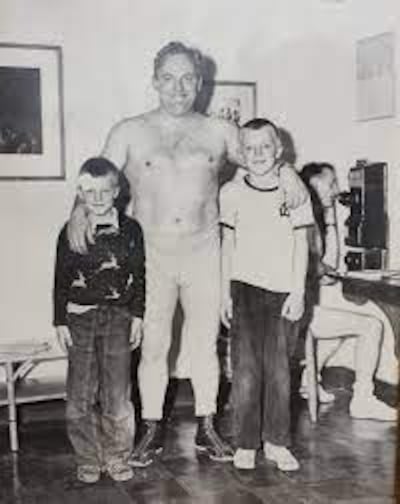In the second half of both their careers, Cork’s Danno Mahony and Boston’s Dr John “Dropkick” Murphy remained box-office enough for a showdown between them to top the bill at the Sports Arena in Lynn, Massachusetts. Billed as a rematch pitting “a pink-cheeked son of the Emerald Isle and czar of the mat behemoths” against “one of the fastest workmen in the ring”, the contest followed an epic contest in which the pair had grappled for over an hour up in Halifax, Nova Scotia. On this early summer’s night in 1940, the Corkman came out on top. After a fashion.
“In the main slambang of the evening, it was a rough performance, for Danno is no longer the good-natured Celt of his first appearance in this country,” went one report. “Considerable hair-pulling, strangling and what-not kept Lloyd Stewart, referee, diligently employing himself as human crowbar to pry Danno from the rough stuff. Danno took the first fall by the Irish whip but the dear doctor won the second with a dropkick. The Irish whip again prevailed for the ex-world’s champ in the third and rubber session.”
Danno will be known to Irish fans, one of those quasi-mythical, sepia-tinted names from the sporting long ago. A giant from Ballydehob, he sailed to America, was sold to the public as a broth of a boy and returned in triumph as heavyweight wrestling champion of the world in 1936, brandishing a diamond-encrusted championship belt supposedly worth $10,000. Like so much about wrestling then, that value was no doubt exaggerated. As for Dropkick Murphy? Well, you might have heard his name mentioned far more recently. In a very different context.

There was something of the WWE pantomime about the way President Joe Biden strutted on to the stage outside St Muredach’s Cathedral in Ballina last month. Making his ring walk to the stirring strains of the Dropkick Murphys’ I’m Shipping up to Boston was clever theatrics and smart politics. For a man battling legit concerns he’s too old to run for re-election, being soundtracked by an Irish-American folk-punk anthem took years off him. Not to mention just about everybody watching had heard this stadium staple at some sports event or other over the past two decades.
Anna Foster continues seamless slide into the pro ranks
First game of Lions tour showed why the lineout is heading for same farcical fate as the scrum
Wimbledon player James McCabe’s Irish father: ‘If the tennis court hadn’t been where we rented, I don’t think he would have picked up a racket’
Teams learn not to poke the Kerry bear
Ken Casey composed the song, inspired by an unpublished fragment of a Woody Guthrie lyric. He has also written the foreword to Dropkick Murphy – A Legendary Life, Emily Sweeney’s evocative new biography of the true original from whom his mighty band took their name. Christened plain old John Eugene Murphy by his parents, Jimmy, a gas fitter, and Cicelie, a tobacco stripper, in blue collar Medford, just north of Boston, in 1912, he gained enduring fame through his various monikers and fascinating second life, all of which is detailed in this book.
[ What's on your rider? Ken Casey of Dropkick MurphysOpens in new window ]
Labelled Dropkick for delivering two-footed shots to opponents’ faces before landing in an upright position, the honorific of doctor was appended because he used wrestling to pay his way through medical school during the Great Depression. The money was so good that he remained in the ring for years after graduation, some newspapers referring to him then as “The Boston Medico”, others preferring the more traditional “man with the cast-iron toes”.
Politicians and journalists in 1930s America suffered periodic bouts of indignation about the brazen fakery involved in the “sport” since most contests were decided well in advance. One state even insisted promoters classify these faux fights as “exhibitions”. Still, anybody willing to work a rigorous schedule and put on a memorable show could make bank. Quickly. Murphy traipsed up and down the east coast for years, often sharing bills with Mahony, Crusher Casey from Sneem (another legend in the arena), and Pat O’Shea, a Carlow native.

His dedication paid off. The same year he fought Danno in Lynn, he purchased an 80-acre spread in Acton that, after opening as a health farm, evolved into New England’s go-to sanatorium where alcoholics received long-term treatment until 1971. In an era when newspapers still advertised mail-order magic pills to cure the disease and one Massachusetts town built a mobile cage to parade drunks through the streets, the good doctor took a more holistic and scientific approach.
One employee told Sweeney, whose forensic research shines through an entertaining book that is a thoroughly delicious slice of Irish-Americana, that the distinctive surnames often made the patient roster read “like the Dublin phone book”. Recurring visitors to the facility included Runyonesque sots such as Narco Norman, One-eyed Murphy and Home run Brady, and, with discretion assured, Boston politicos often checked in to dry out, including one dapper power broker who arrived in some disrepair.
“Everyone knew him, including Murphy,” writes Sweeney. “His handlers explained the situation: He had been playing golf in Dublin, Ireland. One too many drinks, he began getting drunk. His aide frantically placed a call to the State House seeking advice and was told curtly: ‘Bring him back – immediately.’ The avid and inebriated golfer boarded a plane and flew across the Atlantic, landed at Logan Airport, and travelled in a limo to Dropkick Murphys. The golfer was out cold. Twelve hours ticked by and his eyes fluttered open. He stretched his arms, yawned, looking for his clubs. ‘Who am I playing today?’ He thought he was still in Ireland.”
He had, of course, been shipped up to Boston.
Dropkick Murphy – A Legendary Life by Emily Sweeney is published by Hamilcar Publications and is available now
















